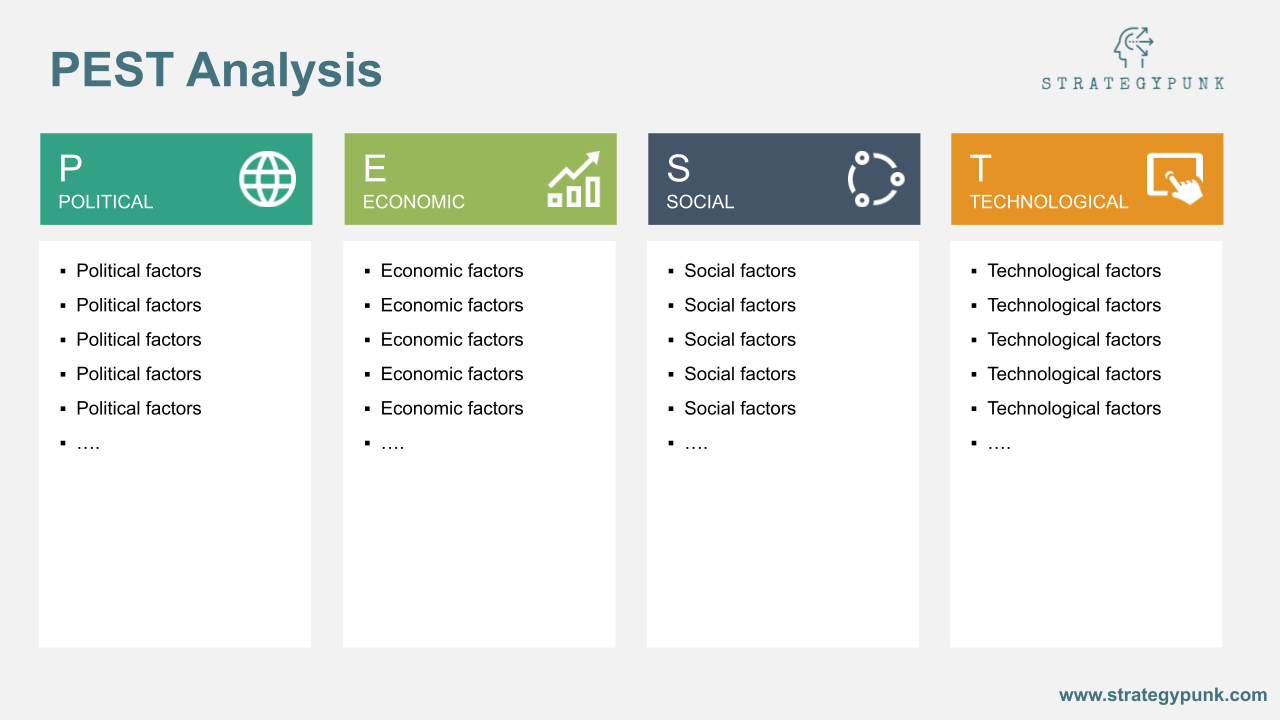Beyond Electric Dreams: Unveiling BYD Through PESTLE Analysis (FREE PPT)
Dive into the future with our FREE PPT on Beyond Electric Dreams: Unveiling BYD. Comprehensive PESTLE Analysis reveals BYD's potential & challenges. Download now!
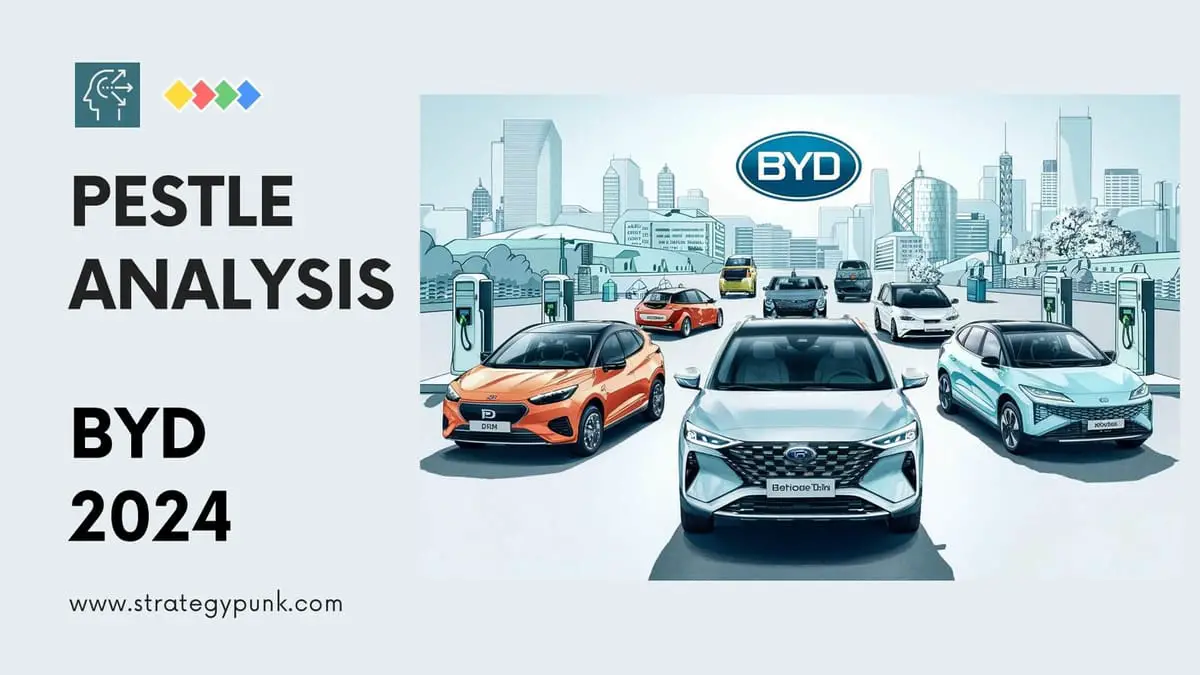
Introduction
In the rapidly evolving landscape of electric vehicles (EVs), one company has emerged as a formidable player, challenging industry giants and redefining the future of transportation. BYD, an acronym for "Build Your Dreams," has captured the automotive world's attention with its innovative technology, ambitious goals, and meteoric rise to prominence.
Founded in 1995 in Shenzhen, China, BYD has transformed from a humble battery manufacturer to a global leader in the EV market, surpassing even Tesla in worldwide sales1.
But what lies beneath the surface of this electric dream? To truly understand BYD's position and potential, we must delve into the intricate web of external factors that shape its trajectory.
This blog post will embark on a comprehensive PESTLE analysis, examining the Political, Economic, Social, Technological, Legal, and Environmental factors that influence BYD's operations and strategies. By unraveling these complex threads, we can gain valuable insights into the challenges and opportunities that await this EV powerhouse as it charges toward an electrified future.
BYD POLITICAL FACTORS
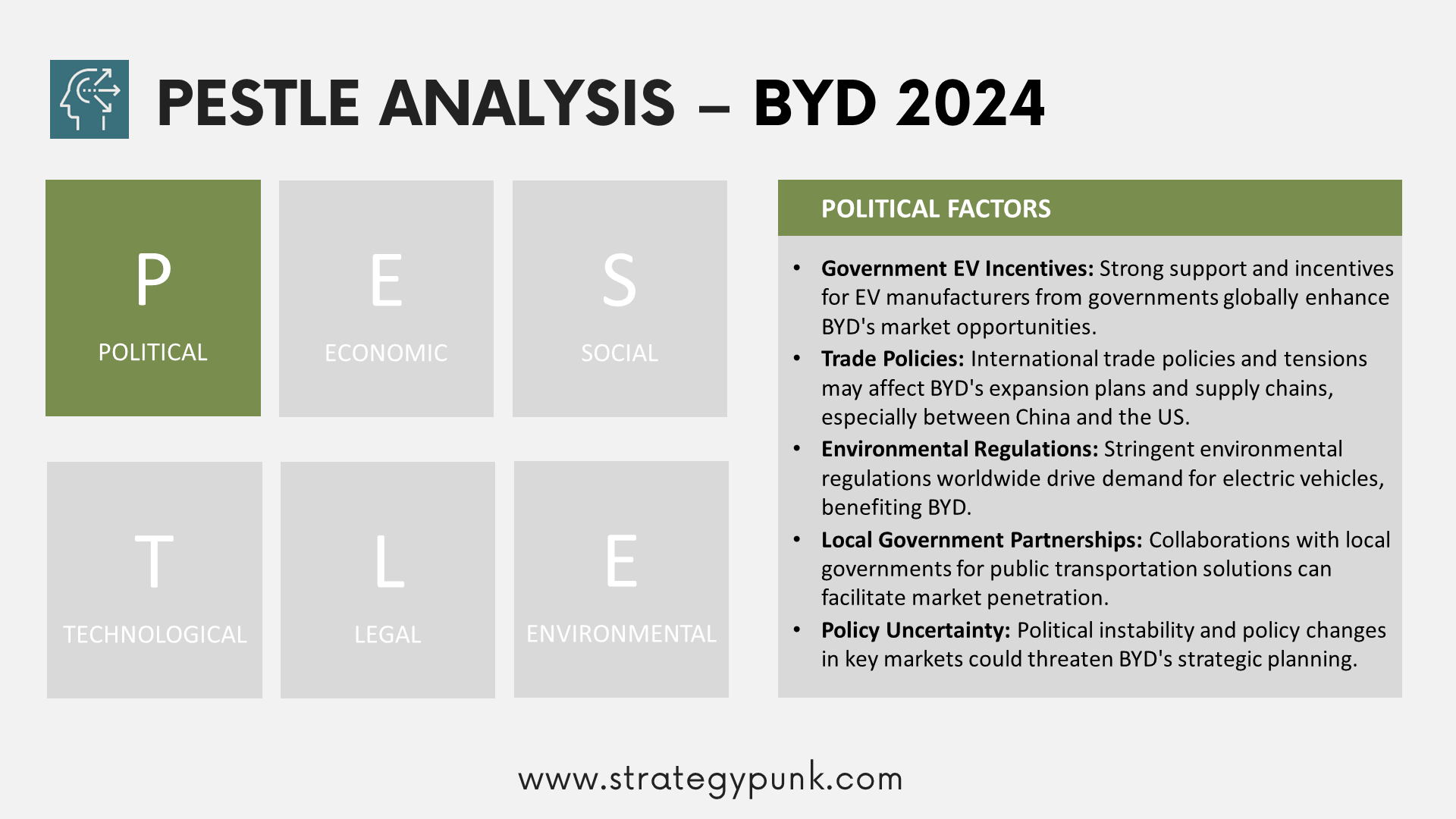
The political landscape plays a crucial role in shaping the destiny of any company, and BYD is no exception. As a Chinese enterprise, BYD is deeply intertwined with the policies and initiatives of the Chinese government. Fortunately for BYD, China has embraced the EV revolution with open arms, implementing a range of supportive measures to accelerate the adoption of electric vehicles.
The Chinese government's commitment to reducing carbon emissions and combating air pollution has paved the way for the rapid growth of the EV industry. Generous subsidies, tax exemptions, and infrastructure investments have created a fertile ground for companies like BYD to thrive.
Moreover, China's ambitious EV sales and production targets have sent a clear signal to the market, encouraging consumers and manufacturers to embrace the electric future.
However, the political landscape is not without its challenges. The ongoing trade tensions between China and the United States have cast a shadow over the global automotive industry, with tariffs and restrictions threatening to disrupt supply chains and market access. With its international aspirations, BYD must navigate these geopolitical headwinds carefully to avoid potential setbacks.
BYD Political Factors Summary
- Government EV Incentives: Strong support and incentives for EV manufacturers from governments globally enhance BYD's market opportunities.
- Trade Policies: International trade policies and tensions may affect BYD's expansion plans and supply chains, especially between China and the US.
- Environmental Regulations: Stringent environmental regulations worldwide drive demand for electric vehicles, benefiting BYD.
- Local Government Partnerships: Collaborations with local governments for public transportation solutions can facilitate market penetration.
- Policy Uncertainty: Political instability and policy changes in key markets could threaten BYD's strategic planning.
BYD ECONOMIC FACTORS
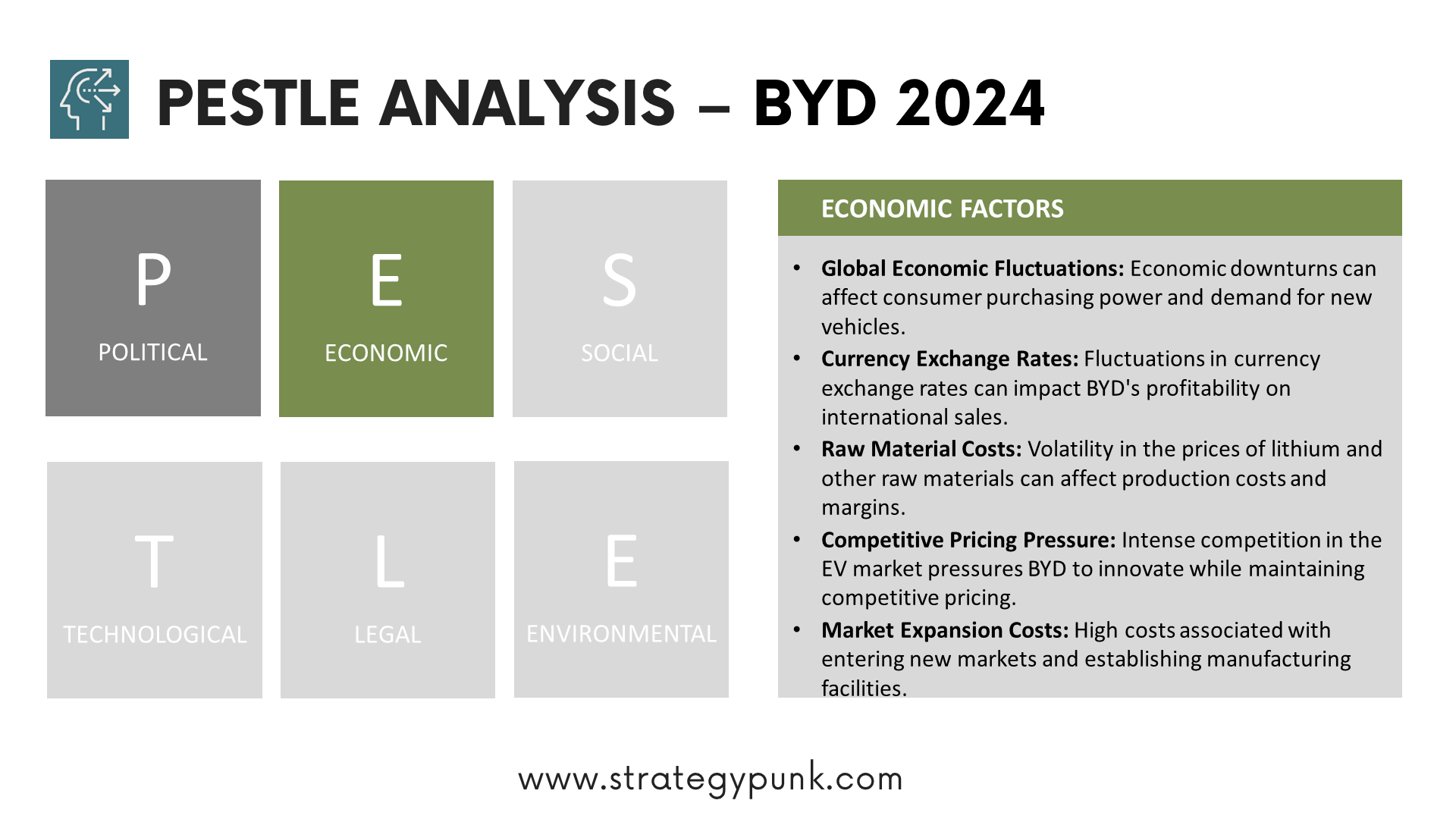
The economic factors surrounding BYD are a complex tapestry of opportunities and challenges. On the one hand, the growing demand for EVs, fueled by increasing environmental awareness and government incentives, presents a massive market opportunity for BYD. As the world's largest automotive market, China's appetite for electric vehicles is insatiable, providing a solid foundation for BYD's growth.
Moreover, BYD's vertical integration strategy, encompassing battery production, vehicle manufacturing, and even monorail systems, allows the company to achieve economies of scale and cost efficiencies1. This integrated approach has offered BYD competitive pricing, making its vehicles accessible to more consumers.
However, the economic landscape is not without its hurdles. The EV industry is characterized by intense competition, with established automakers and startups vying for market share. Tesla's aggressive pricing strategy has initiated the ongoing price war, which has put pressure on BYD and other EV manufacturers to maintain profitability while keeping prices competitive6.
Furthermore, the global economic slowdown, exacerbated by the COVID-19 pandemic, has dampened consumer spending and disrupted supply chains. BYD must navigate these economic headwinds carefully, balancing growth and profitability in an increasingly challenging market.
BYD Economic Factors Summary
- Global Economic Fluctuations: Economic downturns can affect consumer purchasing power and demand for new vehicles.
- Currency Exchange Rates: Fluctuations in currency exchange rates can impact BYD's profitability on international sales.
- Raw Material Costs: Volatility in the prices of lithium and other raw materials can affect production costs and margins.
- Competitive Pricing Pressure: Intense competition in the EV market pressures BYD to innovate while maintaining competitive pricing.
- Market Expansion Costs: High costs associated with entering new markets and establishing manufacturing facilities.
BYD SOCIAL FACTORS
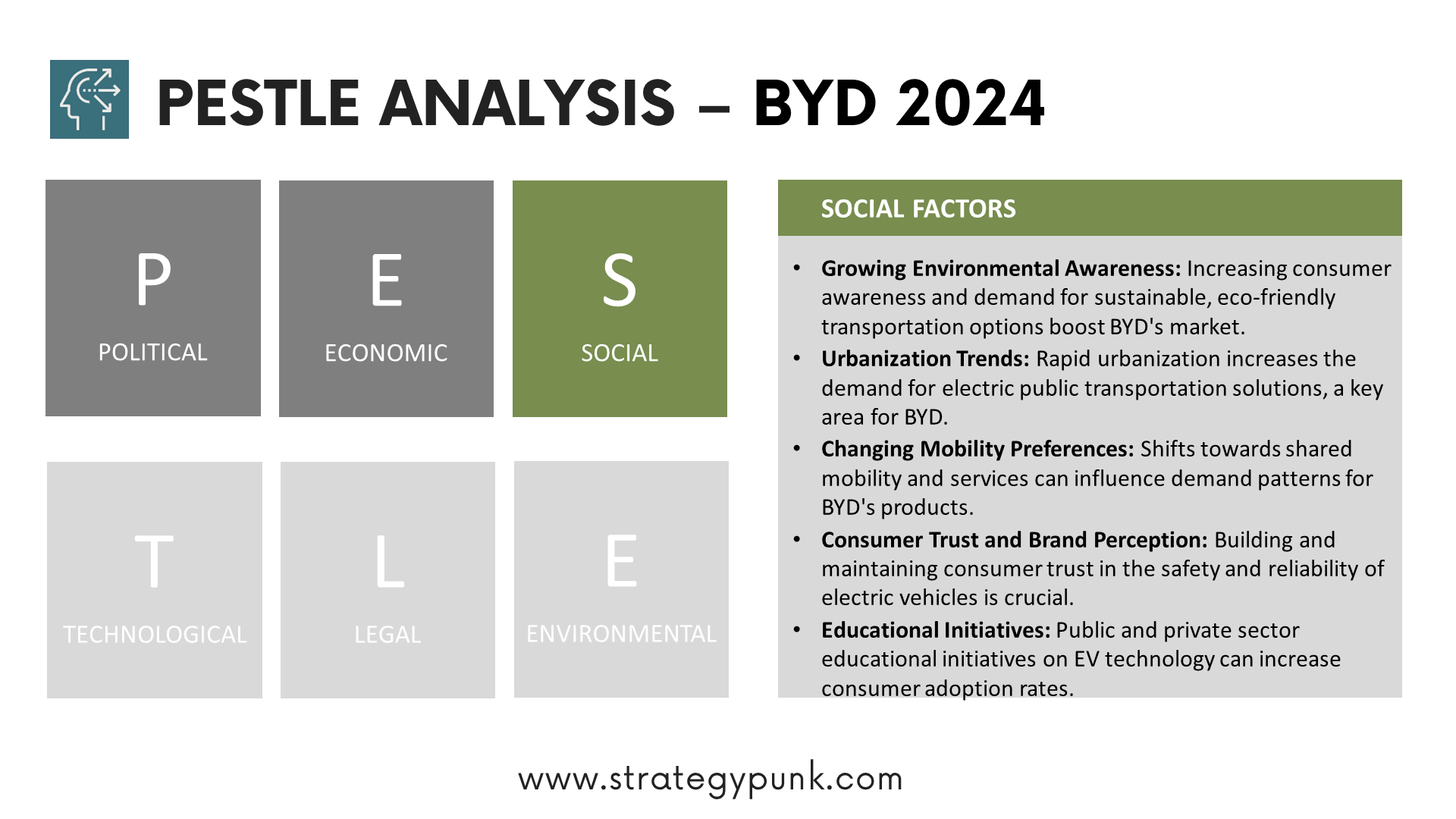
The social factors surrounding BYD reflect consumers' changing attitudes and preferences in the age of electric mobility. As environmental consciousness grows, more and more people are embracing EVs as a cleaner, greener alternative to traditional gasoline-powered vehicles. This shift in consumer behavior bodes well for BYD, as it positions the company to capitalize on the growing demand for sustainable transportation solutions.
Moreover, the rise of the middle class in China and other emerging markets has created a new generation of consumers who continue to improve their vehicle technology and are eager to embrace cutting-edge technology and premium features2. BYD's focus on innovation and user experience aligns well with these evolving consumer expectations, allowing the company to capture a loyal customer base.
However, social factors also present challenges for BYD. Range anxiety and concerns about charging infrastructure still hinder the adoption of EVs. To overcome these barriers, BYD must continue to improve its vehicle technology and work closely with governments and partners to expand the charging network and educate consumers about the benefits of electric mobility.
BYD Social Factors Summary
- Growing Environmental Awareness: Increasing consumer awareness and demand for sustainable, eco-friendly transportation options boost BYD's market.
- Urbanization Trends: Rapid urbanization increases the demand for electric public transportation solutions, a key area for BYD.
- Changing Mobility Preferences: Shifts towards shared mobility and services can influence demand patterns for BYD's products.
- Consumer Trust and Brand Perception: Building and maintaining consumer trust in the safety and reliability of electric vehicles is crucial.
- Educational Initiatives: Public and private sector educational initiatives on EV technology can increase consumer adoption rates.
BYD TECHNOLOGICAL FACTORS
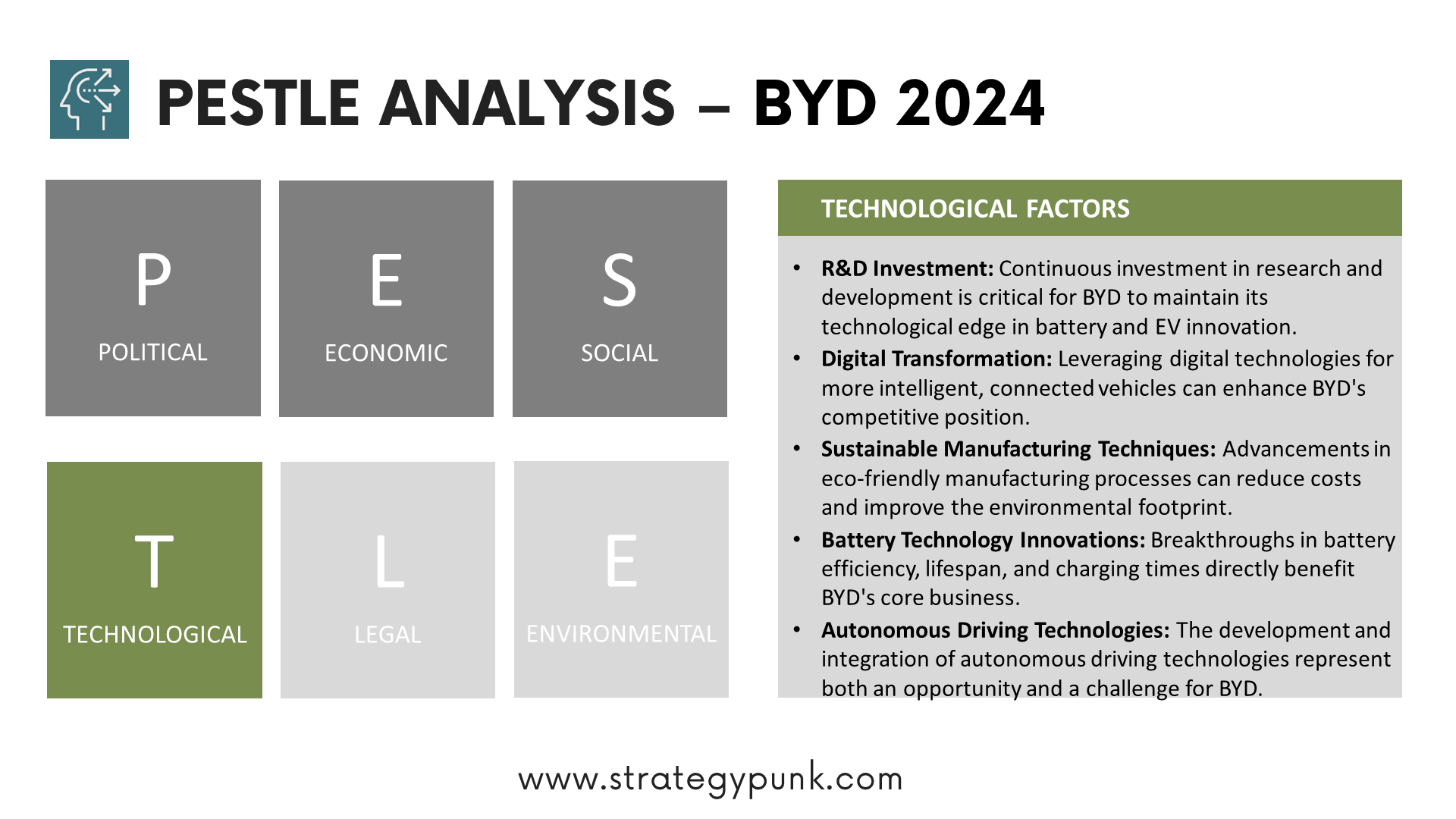
Technology lies at the heart of BYD's success, and its ability to innovate and adapt will determine its future in the fast-paced world of electric vehicles. BYD's expertise in battery technology, honed through years of experience in the mobile phone industry, has given the company a significant advantage in the EV market1. The development of the Blade Battery, with its ultra-safe and high-performance characteristics, has set BYD apart from its competitors13.
Moreover, BYD's investments in research and development have yielded a range of cutting-edge technologies, from the DM-i hybrid system to the e-Platform 3.0 for intelligent electric vehicles13. These technological advancements have positioned BYD at the forefront of the EV revolution, enabling the company to offer vehicles with longer ranges, faster charging times, and enhanced user experiences.
However, the technological landscape constantly evolves, and BYD must remain vigilant to stay ahead of the curve. The rapid advancements in battery chemistry, autonomous driving, and connectivity present opportunities and challenges for the company. To maintain its competitive edge, BYD must continue to invest heavily in research and development, forge strategic partnerships, and adapt quickly to emerging trends and technologies.
BYD Technological Factors Summary
- R&D Investment: Continuous investment in research and development is critical for BYD to maintain its technological edge in battery and EV innovation.
- Digital Transformation: Leveraging digital technologies for more intelligent, connected vehicles can enhance BYD's competitive position.
- Sustainable Manufacturing Techniques: Advancements in eco-friendly manufacturing processes can reduce costs and improve the environmental footprint.
- Battery Technology Innovations: Breakthroughs in battery efficiency, lifespan, and charging times directly benefit BYD's core business.
- Autonomous Driving Technologies: The development and integration of autonomous driving technologies represent both an opportunity and a challenge for BYD.
BYD LEGAL FACTORS
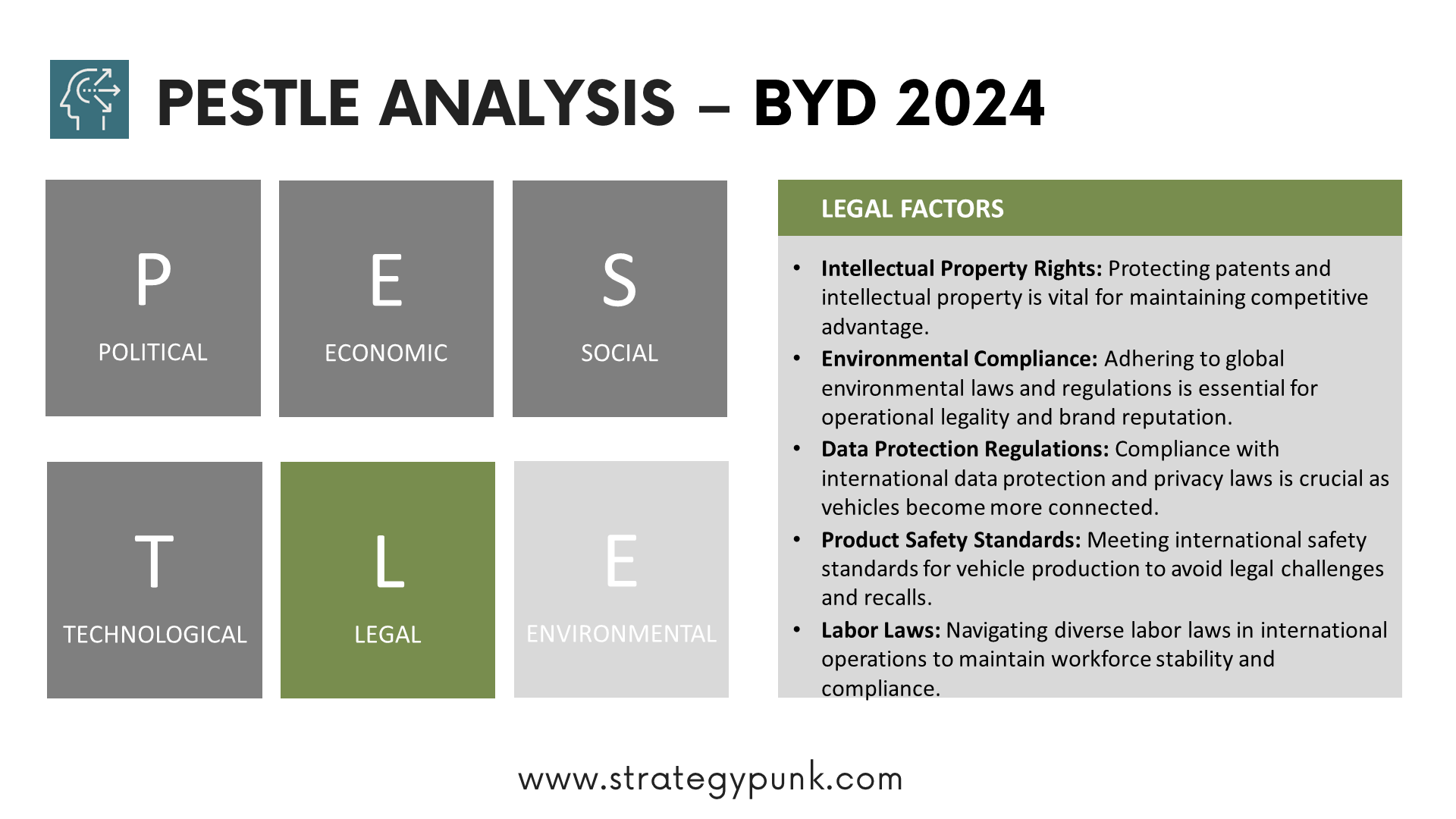
The EV industry's legal landscape is a complex web of regulations, standards, and intellectual property rights. As a global player, BYD must navigate a myriad of legal frameworks across different markets, ensuring compliance with local laws and regulations.
In China, the government's strong support for the EV industry has created a favorable legal environment for BYD2. Policies such as the New Energy Vehicle (NEV) mandate, which requires automakers to produce a certain percentage of EVs, have provided a clear roadmap for the industry's growth. Moreover, China's stringent emissions standards and fuel economy regulations have further incentivized the adoption of electric vehicles.
However, as BYD expands its presence in international markets, it must contend with a patchwork of legal requirements and standards. Differences in safety regulations, charging protocols, and consumer protection laws can create challenges for BYD as it seeks to establish a global footprint. Moreover, the company must protect its intellectual property rights, as the EV industry is rife with patent disputes and technology theft.
BYD Legal Factors Summary
- Intellectual Property Rights: Protecting patents and intellectual property is vital for maintaining competitive advantage.
- Environmental Compliance: Adhering to global environmental laws and regulations is essential for operational legality and brand reputation.
- Data Protection Regulations: Compliance with international data protection and privacy laws is crucial as vehicles become more connected.
- Product Safety Standards: Meeting international safety standards for vehicle production to avoid legal challenges and recalls.
- Labor Laws: Navigating diverse labor laws in international operations to maintain workforce stability and compliance.
BYD ENVIRONMENTAL FACTORS
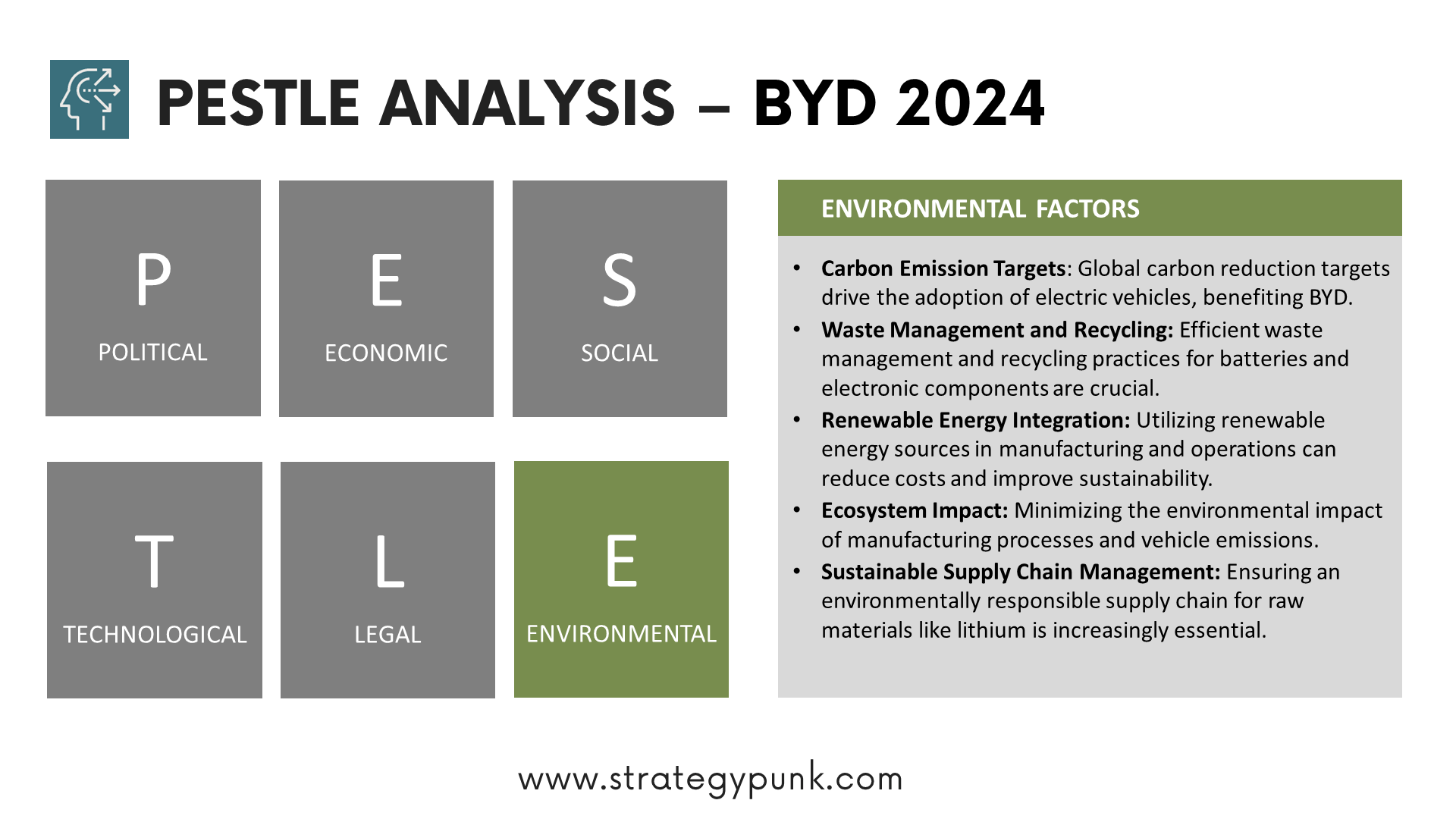
Environmental factors are at the core of BYD's mission and purpose. The company's commitment to building a sustainable future through electric mobility is a moral imperative and a strategic advantage in an increasingly environmentally conscious world13.
The urgent need to combat climate change and reduce carbon emissions has created a powerful tailwind for the EV industry2. Governments worldwide are setting ambitious targets for the phase-out of internal combustion engines and adopting electric vehicles. This global push towards electrification presents a massive opportunity for BYD to expand its market share and make a meaningful impact on the environment.
Moreover, BYD's integrated approach to sustainability, encompassing electric vehicles, renewable energy solutions, and monorail systems, positions the company as a leader in the green economy1.
BYD can tap into the growing demand for sustainable solutions across multiple sectors by offering a comprehensive portfolio of environmentally friendly products and services.
However, the environmental landscape also presents challenges for BYD. Producing electric vehicles and batteries requires significant raw materials, such as lithium and cobalt, which can have negative environmental and social impacts. To maintain its ecological credibility, BYD must ensure that its supply chains are sustainable and ethical and that its production processes minimize waste and pollution.
BYD Environmental Factors Summary
- Carbon Emission Targets: Global carbon reduction targets drive the adoption of electric vehicles, benefiting BYD.
- Waste Management and Recycling: Efficient waste management and recycling practices for batteries and electronic components are crucial.
- Renewable Energy Integration: Utilizing renewable energy sources in manufacturing and operations can reduce costs and improve sustainability.
- Ecosystem Impact: Minimizing the environmental impact of manufacturing processes and vehicle emissions.
- Sustainable Supply Chain Management: Ensuring an environmentally responsible supply chain for raw materials like lithium is increasingly essential.
Conclusion PESTLE Analysis BYD
This comprehensive PESTLE analysis unveiled the complex web of factors that shape BYD's trajectory in the electric vehicle industry.
From the Chinese government's supportive policies to consumers' changing preferences, from rapid technological advancements to the urgent need for environmental sustainability, BYD must navigate a dynamic and challenging landscape.
Yet, amidst these challenges, BYD's strengths shine through. The company's expertise in battery technology, its vertically integrated business model, and its commitment to innovation position it as a formidable player in the global EV market. As the world accelerates towards an electric future, BYD stands poised to lead the charge, turning electric dreams into a sustainable reality.
The road ahead is not without obstacles, but BYD's resilience, adaptability, and vision have propelled it to the forefront of the EV revolution. As we watch this remarkable company continue to build its dreams, we can be sure that the future of transportation is electric, and BYD will be at the wheel.
Key Facts to BYD (Build Your Dreams)
Founded by Wang Chuanfu in February 1995
Headquarters: Shenzhen, Guangdong, China
Key Products: Electric vehicles, automobiles, solar panels, rechargeable batteries
World's largest Electric vehicle manufacturer
Revenue: CN¥584.4 billion, US$82.09 billion (2023)
Number of employees: Approximately 570,000 (2022)
BYD PESTLE Analysis PowerPoint Template
free and fully editable PPT template
Understanding the multifaceted external environment is crucial for strategic planning and decision-making in the ever-evolving electric vehicle (EV) and battery technology industry.
The BYD PESTLE Analysis PowerPoint Template is designed to offer a comprehensive overview of the political, economic, social, technological, legal, and environmental factors that are shaping the future of BYD, one of the leading companies in this sector.
This template distills complex analyses into digestible bullet points, providing a clear framework for strategists, consultants, and stakeholders to identify opportunities and challenges, make informed decisions, and tailor strategies to navigate the global market effectively.
Whether you're presenting to executives, collaborators, or academic audiences, this template is an indispensable tool for conveying the strategic landscape that BYD operates within.

BYD PESTLE Analysis PowerPoint Template
BYD PESTLE Analysis PDF Template
Discover more
Clickworthy Resources
BYD SWOT Analysis: Free PPT Template and In-Depth Insights 2024
Download the free BYD SWOT Analysis PowerPoint Template 2024. Get in-depth insights into BYD's strengths, weaknesses, opportunities, and threats. Ideal for strategic planning and market analysis.
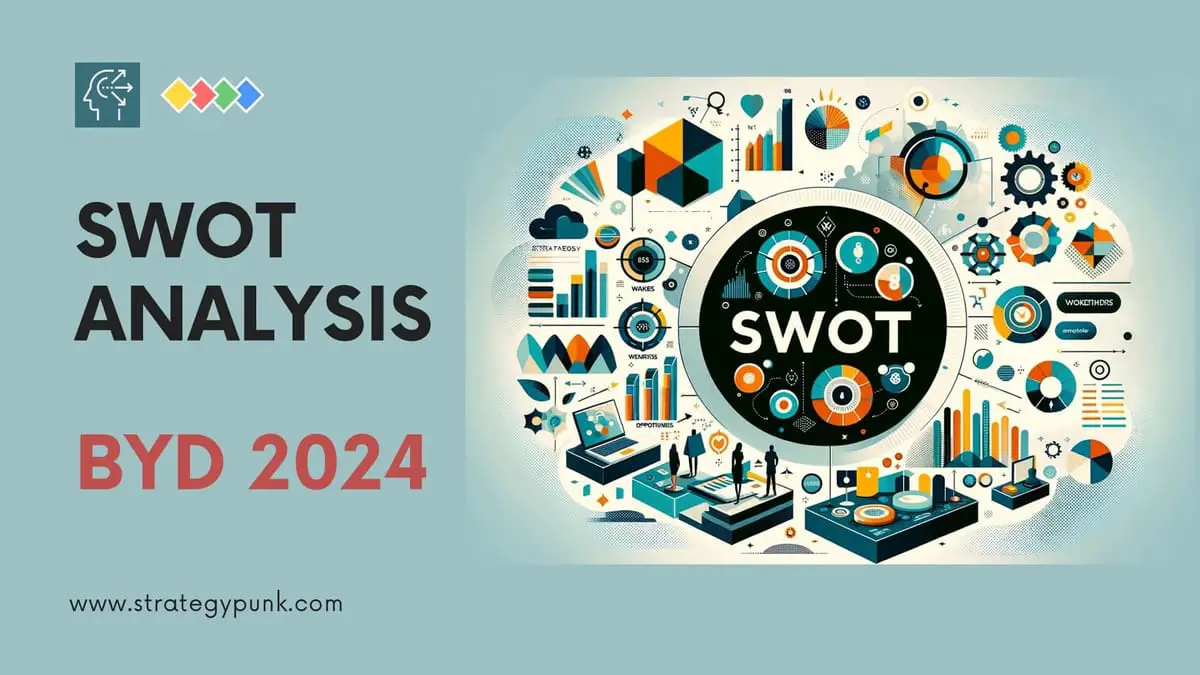
Porter's 5 Forces Analysis for BYD: Free PPT Template and In-Depth Insights 2024
Download our free PowerPoint template for Porter's 5 Forces Analysis specifically designed for BYD. Gain in-depth insights into the competitive landscape with our 2024 guide. Essential for strategists and analysts.
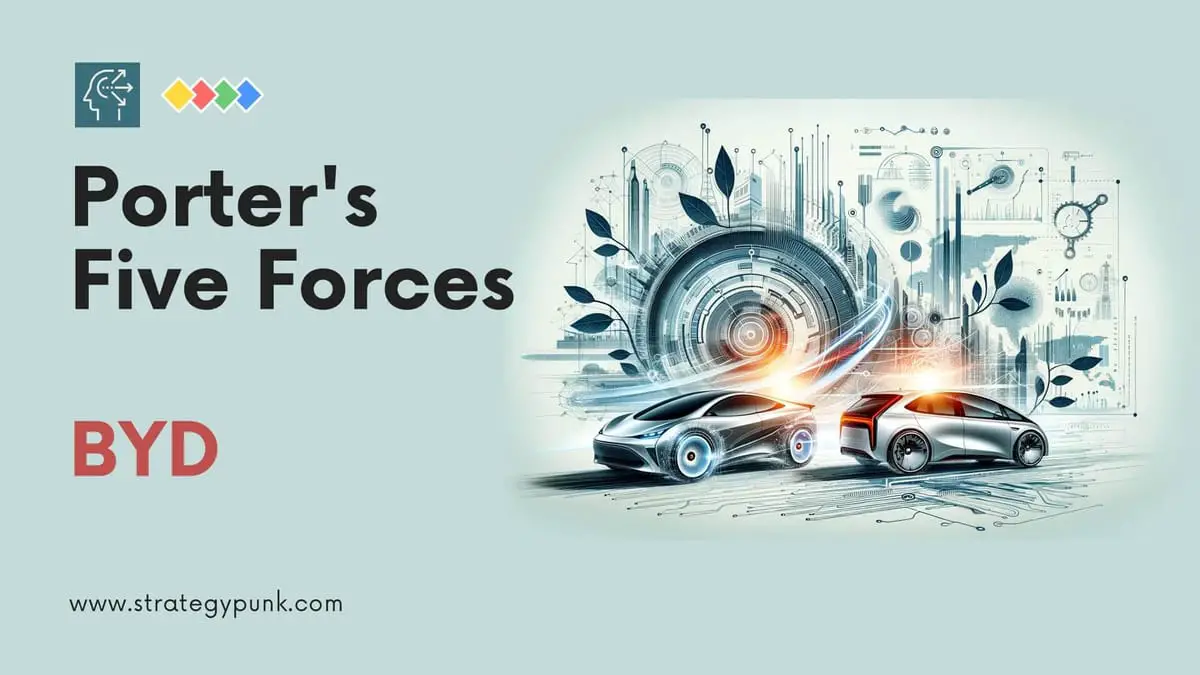
The Basics of a PEST / PESTLE Analysis: A Complete Guide (Plus FREE Template)
The Basics of a PEST / PESTLE Analysis: A Complete Guide (Plus FREE Powerpoint and Googel SlidesTemplate)
